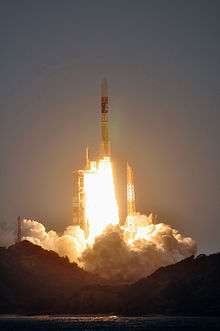Our website is made possible by displaying online advertisements to our visitors.
Please consider supporting us by disabling your ad blocker.
Japanese space program
This article has been translated from the article 日本の宇宙開発 in the Japanese Wikipedia, and requires proofreading. (August 2022) |
| 日本の宇宙開発 | |
 Launch of the Japanese rocket H-IIA | |
| First flight | 12 April 1955 (Pencil Rocket) |
|---|---|
| Successes | 60 |
| Failures | 2 |
| Partial failures | 1 |
The Japanese space program (Japanese: 日本の宇宙開発) originated in the mid-1950s as a research group led by Hideo Itokawa at the University of Tokyo. The size of the rockets produced gradually increased from under 30 cm (12 in) at the start of the project, to over 15 m (49 ft) by the mid-1960s. The aim of the original research project was to launch a man-made satellite.
By the 1960s, two organizations, the Institute of Space and Astronautical Science (ISAS) and the National Space Development Agency of Japan (NASDA), were developing their own rockets. After experiencing numerous failures in the 1990s and 2000s, ISAS and NASDA merged — along with the National Aerospace Laboratory of Japan (NAL) — to form the unified Japan Aerospace Exploration Agency (JAXA) in 2003. In recent years, Japanese space policy has been shaped by the US-Japan alliance and intensifying great power competition.[1]
- ^ Pekkanen, Saadia M. (2023). "Space and the US–Japan alliance: reflections on Japan's geopolitical and geoeconomic strategy". Japanese Journal of Political Science. 24 (1): 64–79. doi:10.1017/S1468109922000317. ISSN 1468-1099.
Previous Page Next Page


